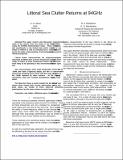Files in this item
Littoral sea clutter returns at 94GHz
Item metadata
| dc.contributor.author | Stove, A.G. | |
| dc.contributor.author | Robertson, D.A. | |
| dc.contributor.author | Macfarlane, D.G. | |
| dc.date.accessioned | 2016-07-18T16:30:03Z | |
| dc.date.available | 2016-07-18T16:30:03Z | |
| dc.date.issued | 2014-03-12 | |
| dc.identifier | 190537554 | |
| dc.identifier | dee79fb1-08fd-478e-a75c-84ce6037b3b8 | |
| dc.identifier | 84946689462 | |
| dc.identifier | 000382379800070 | |
| dc.identifier.citation | Stove , A G , Robertson , D A & Macfarlane , D G 2014 , Littoral sea clutter returns at 94GHz . in 2014 International Radar Conference (Radar 2014) . , 7060308 , 2014 International Radar Conference , IEEE , Radar Conference (Radar), 2014 International , Lille , France , 13/10/14 . https://doi.org/10.1109/RADAR.2014.7060308 | en |
| dc.identifier.citation | conference | en |
| dc.identifier.isbn | 9781479941957 | |
| dc.identifier.issn | 1097-5764 | |
| dc.identifier.other | ORCID: /0000-0002-4042-2772/work/42588106 | |
| dc.identifier.uri | https://hdl.handle.net/10023/9158 | |
| dc.description.abstract | This paper reports and discusses measurements made of the returns from sea clutter in the littoral at 94GHz using the SAFIRE demonstration radar. These measurements add significantly to the limited data which is available on sea clutter at 94GHz as well as showing how a radar developed to assist the public understanding of technology can also be used for research purposes. Littoral clutter measurements are proportionately more important at 94GHz than at lower frequencies because the short range of radars at these frequencies means that they are much more likely to be operating in this environment than in the open sea. The measurements show peak backscatter levels of about -22dB (sea state 3, 2° grazing angle), but this is concentrated around the breaking wave crests, and the mean value is close to the -30dB reported by other workers. At the high range resolutions used, the resultant distributions appear very longtailed. The data also shows a useful insight into the behaviour of sea clutter when viewed with circular polarisation, for which the peak values are similar to those observed with linear polarisations, but the mean values are much lower. | |
| dc.format.extent | 6 | |
| dc.format.extent | 431039 | |
| dc.language.iso | eng | |
| dc.publisher | IEEE | |
| dc.relation.ispartof | 2014 International Radar Conference (Radar 2014) | en |
| dc.relation.ispartofseries | 2014 International Radar Conference | en |
| dc.subject | Circular polarisation | en |
| dc.subject | Millimetre-wave | en |
| dc.subject | Sea clutter | en |
| dc.subject | QC Physics | en |
| dc.subject | Computer Science Applications | en |
| dc.subject | Computer Networks and Communications | en |
| dc.subject | Signal Processing | en |
| dc.subject | Electrical and Electronic Engineering | en |
| dc.subject.lcc | QC | en |
| dc.title | Littoral sea clutter returns at 94GHz | en |
| dc.type | Conference item | en |
| dc.contributor.institution | University of St Andrews. School of Physics and Astronomy | en |
| dc.identifier.doi | https://doi.org/10.1109/RADAR.2014.7060308 |
This item appears in the following Collection(s)
Items in the St Andrews Research Repository are protected by copyright, with all rights reserved, unless otherwise indicated.

